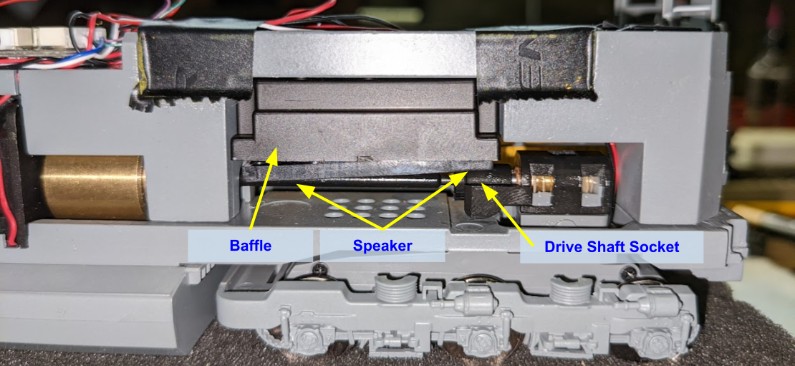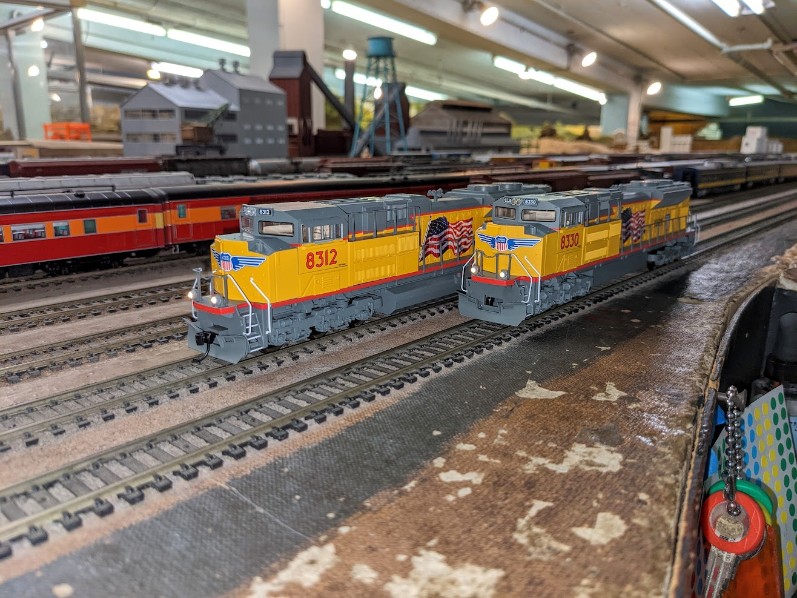The Randall Museum in San Francisco hosts a large HO-scale model model railroad. Created by the Golden Gate Model Railroad Club starting in 1961, the layout was donated to the Museum in 2015. Since then I have started automatizing trains running on the layout. I am also the model railroad maintainer. This blog describes various updates on the Randall project and I maintain a separate blog for all my electronics not directly related to Randall.
2022-10-11 - More Issues with the Walthers Mainline SD70ACe
Category RandallThe saga with the new Walthers Mainline SD70ACe continues.
You can read more details in the other blog where I nearly glue my fingers trying to attach the loose parts, I’m having a lot of fun (not) removing the SD70ACe shell, and I’m seriously appalled when I realize the source of the drive noise from the engines out of the box -- I’ll give you this to admire:
OK fine, so once all these things are repaired, the engines are definitely going to be awesome!
Not.
ESU LokSound Auto-tune
The ESU LokSound decoder has a neat feature: an “Auto Tune” procedure to recompute the BEMF & load compensation for the engines. I’ve used it before and it’s great to get very good crawling speed out of these engines.
Normally the procedure is to turn all functions off, set CV 54 to 0, then send an F1 command. The engine runs for a few feet and adjusts its BEMF values.
Except when I tried that I got… nothing. It’s as-is the feature was not present in these engines. OK fine, I set back CV 54 to its default factory value of 50. There’s a bit of a mystery here, which I don’t like, but let’s move on
First Test Run
Let’s break-in these engines. I put them both on the mainline in parallel tracks. #8312 starts moving smoothly while #8330 does… nothing? Then I realize even its headlight doesn’t turn on. Nor the sound. OK fine there’s no track power, right? Nope, I try with one of the DCC flag men and there’s definitely power on that track.
I reach to move the engine when I realize, outch, the hood is hot. Huh that’s not a good sign. That’s exactly where the DCC decoder is located. It’s essentially overheating.
I quickly take the engine off the track, and back to the programming track, where I also constate that it does not indeed move.
Back on the bench, I remove the Walthers Mainline SD70ACe shell. Although the ESU LokSound is a bit warm, there is nothing obvious that could signal a short. At least no blackened tracks on the DCC decoder board, and no wires are exposed. I really see nothing even remotely noteworthy. I try the engine with the shell open on the programming track and it seems to work just fine. It responds to DCC commands for lights and speed, which it did not when it was overheating.
No idea what happened, but it seems to be working now. I carefully put back the shell, making sure I’m not pinching any wire. Then I try the engine again on the programming track and it works fine. There’s a bit of a mystery here, which I don’t like, but let’s move on.
Second Test Run
Back on the mainline, I try both engines and they seem to be pretty well speed matched; running them on parallel tracks, they seem to have matching speeds. I go back and forth a few times, and suddenly I realize I have no control over #8312. It starts making a weird continuous noise like a dynamic brake noise, and I can’t stop the engine, nor does it respond to any other DCC command. Eventually the engine overruns the end of the spur on the reversed turnout, shorting in the process, and that stops it. That seems to reset it and I have control again.
That has to be a fluke, so I do a few more back and forth runs on the parallel track at different speeds and again, #8312 locks up and runs without responding to DCC commands. Losing power again resets the engine.
Final Test Run
Finally I decide I’ll just run the engines along the entire mainline at a middle speed (16 out of 28) which looks like a descent moving speed. Since both engines seemed fairly well speed matched, I consist them together with the NCE controller, and run them on the mainline, albeit a couple feet of separation.
Off they go after Stockton Station and bam, they haven’t even reached Sonora that again both engines make the weird dynamics noise and I realize I have no control over them at all. This time it’s both of them, so it’s not an isolated incident anymore.
This is getting very frustrating and eerie so at that point I just pull off the engines from the track and stick them on the workbench. I’ll try another time later.

